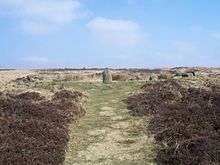Barbrook One
 | |
 Shown within Derbyshire | |
| Location | Ramsley Moor, Peak District |
|---|---|
| Coordinates | 53°16′35″N 1°35′01″W / 53.27652°N 1.583735°WCoordinates: 53°16′35″N 1°35′01″W / 53.27652°N 1.583735°W |
| Type | Stone circle |
| History | |
| Periods | Bronze Age |
Barbrook One (grid reference SK27857558) is a stone circle on Ramsley Moor in the Peak District.
Description[]
"Barbrook No. 1" is an embanked stone circle.[1] It has one large standing stone (1 metre high) and 11 smaller stones (5 cm to 25 cm high).[1] The circle has an internal diameter of about 13 metres, and it is surrounded by a rubble bank 3 metres wide.[1]
The stone circle stands in a cairn field on Ramsley Moor. This includes "Barbrook No. 2" which is a ring cairn consisting of a rubble bank with internal diameter 13 metres.[2] It is about 200 metres to the north by northwest of Barbrook 1.[2] All together there are about 80 cairns on Ramsley Moor.[3] The majority are less than 6 metres in diameter.[3] Many are believed to be clearance cairns of later prehistoric date. Some of the larger cairns are likely to be Bronze Age funerary monuments.[3] The area is a designated Scheduled Ancient Monument.[4]
Two kilometres to the north is another stone circle known as "Barbrook No. 3" (or "Barbrook III").[5]
Notes[]
- ^ a b c Historic England. "Monument No. 311677". Research records (formerly PastScape). Retrieved 7 November 2013.
- ^ a b Historic England. "Monument No. 311641". Research records (formerly PastScape). Retrieved 7 November 2013.
- ^ a b c Historic England. "RAMSLEY MOOR CAIRNS (1323424)". Research records (formerly PastScape). Retrieved 7 November 2013.
- ^ Historic England. "Prehistoric landscape on Big Moor and Ramsley Moor (1004599)". National Heritage List for England. Retrieved 15 February 2014.
- ^ Historic England. "Monument No. 311674". Research records (formerly PastScape). Retrieved 7 November 2013.
- Stone circles in Derbyshire
- Scheduled monuments in Derbyshire
- Bronze Age sites in Derbyshire
- East Midlands building and structure stubs
